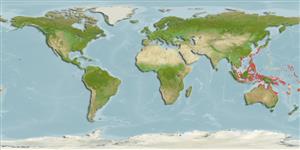>
Blenniiformes (Blennies) >
Blenniidae (Combtooth blennies) > Blenniinae
Etymology: Omobranchus: Greek, omo = shoulder + Greek, brangchia = gill (Ref. 45335).
More on author: Sauvage.
Environment: milieu / climate zone / depth range / distribution range
Ecología
marino asociado a arrecife; rango de profundidad 0 - 3 m (Ref. 90102). Tropical
Western Pacific: Taiwan and Hong Kong to New Caledonia (Ref. 40966).
Tamaño / Peso / Age
Maturity: Lm ? range ? - ? cm
Max length : 8.0 cm TL macho / no sexado; (Ref. 36661)
Espinas dorsales (total): 12 - 14; Radios blandos dorsales (total): 18-23; Espinas anales 2; Radios blandos anales: 21 - 26. Head with wavy vertical lines, pale-rimmed dark spot just behind eye, oblique brownish bands, and curved white lines on side. Dorsal rays usually XIII, fin slightly notched between spinous and soft portions; 3 mandibular pores on each side; gill opening extending ventrally from slightly above pectoral-fin base to opposite 6th pectoral ray; head crest and cirri absent; last dorsal and anal rays attached by membrane to caudal fin; body depth about 5.8 in SL. Maximum size to 7.8 cm TL (Ref. 90102).
Adults inhabit shallow reefs, in crevices just below level of low tide (Ref. 36661). Found in tidepools and rocky shores, solitary or in small groups (Ref. 90102). Oviparous. Eggs are demersal and adhesive (Ref. 205), and are attached to the substrate via a filamentous, adhesive pad or pedestal (Ref. 94114). Larvae are planktonic, often found in shallow, coastal waters (Ref. 94114).
Life cycle and mating behavior
Madurez | Reproducción | Puesta | Huevos | Fecundidad | Larva
Oviparous, distinct pairing (Ref. 205).
Allen, G.R., 1997. The marine fishes of tropical Australia and south-east Asia. Western Australian Museum, Perth, Western Australia. 292 p. (Ref. 36661)
IUCN Red List Status (Ref. 130435)
Threat to humans
Harmless
Human uses
Más información
ReferenciasAcuiculturaPerfil de acuiculturaRazasGenéticaElectrophoresesheritabilidadEnfermedadesProcesamientoNutrientsMass conversion
ColaboradoresImágenesStamps, Coins Misc.SonidosCiguateraVelocidadTipo de nataciónSuperficie branquialOtolitosCerebrosVisión
Herramientas
Special reports
Download XML
Fuentes de Internet
Estimates based on models
Preferred temperature (Ref.
123201): 24.7 - 29.2, mean 28.6 °C (based on 1444 cells).
Phylogenetic diversity index (Ref.
82804): PD
50 = 0.5000 [Uniqueness, from 0.5 = low to 2.0 = high].
Bayesian length-weight: a=0.00562 (0.00258 - 0.01228), b=3.06 (2.87 - 3.25), in cm total length, based on LWR estimates for this (Sub)family-body shape (Ref.
93245).
Nivel trófico (Ref.
69278): 2.6 ±0.1 se; based on size and trophs of closest relatives
Resiliencia (Ref.
120179): Alto, población duplicada en un tiempo mínimo inferior a 15 meses (Preliminary K or Fecundity.).
Fishing Vulnerability (Ref.
59153): Low vulnerability (10 of 100).
Nutrients (Ref.
124155): Calcium = 196 [94, 333] mg/100g; Iron = 0.901 [0.498, 1.558] mg/100g; Protein = 18.3 [17.0, 19.4] %; Omega3 = 0.0809 [, ] g/100g; Selenium = 16.4 [7.3, 36.8] μg/100g; VitaminA = 139 [40, 476] μg/100g; Zinc = 2.51 [1.62, 3.70] mg/100g (wet weight);
